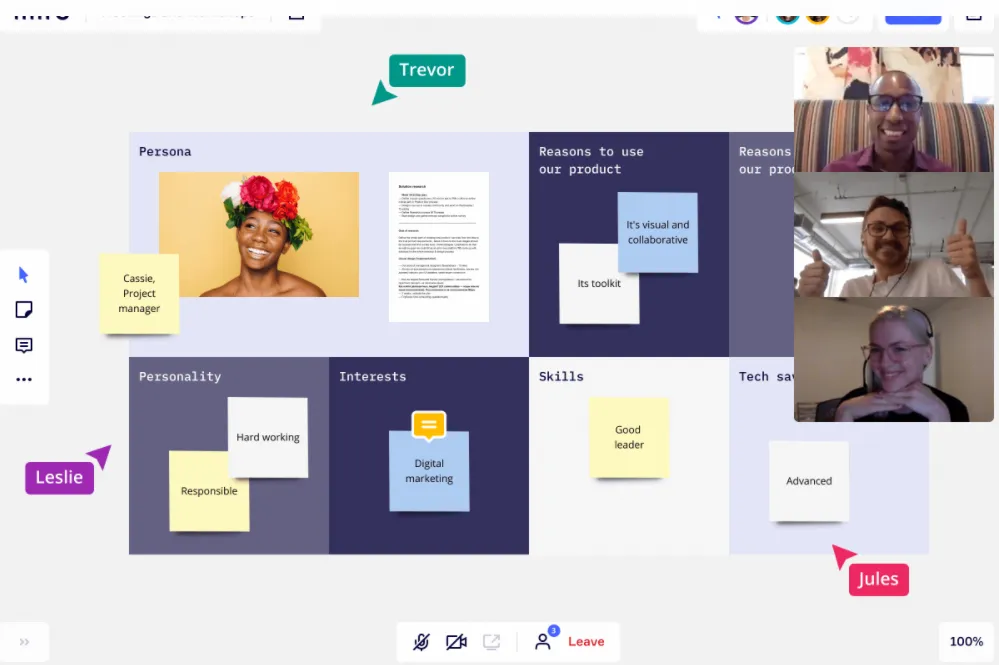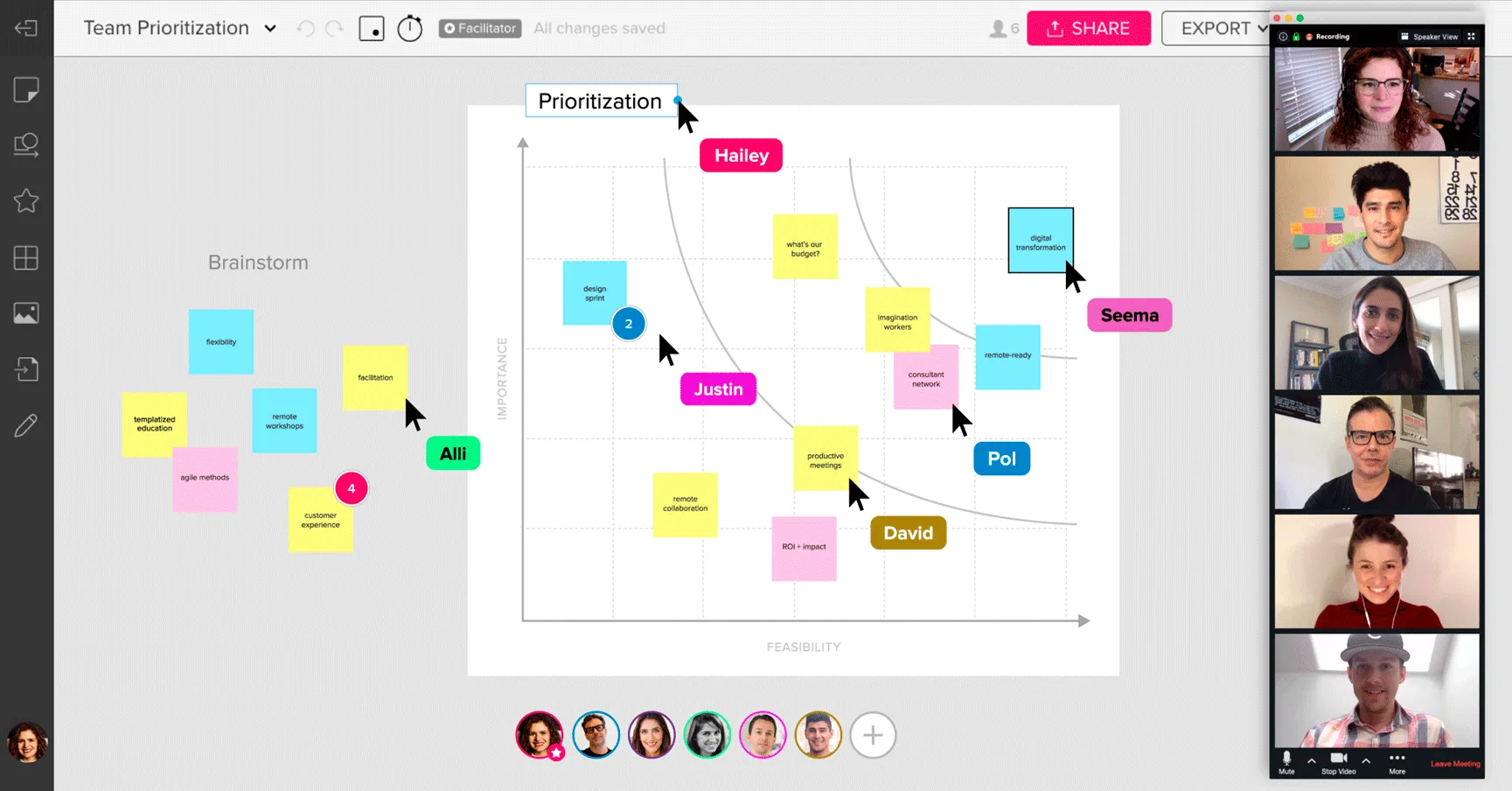Due to the coronavirus epidemic, a lot of workshops, conferences and events have been cancelled. Some organizations decided to switch to a virtual world and conduct them remotely but it demands accurate preparations.
Shifting to a remote-only Event Storming session requires a different approach to be as successful as an in-person event. As in the offline session, things may not go as planned; flexibility and adaptation to the unexpected will go a long way in delivering a valuable outcome. This reality increases in a remote-only setting because it’s much more difficult to run a collaboration workshop, monitor body language, and quickly course correct.
Therefore, in this post, I will share with you some tips and tricks on how to run an effective Event Storming session in a remote manner.
What is Event Storming?
Before we go into details, let’s recall what Event Storming is. It is a workshop technique proposed by Albert Brandolin, specially dedicated to doing it offline. Its core value is placed in gathering all necessary people in one room in order to run a fruitful conversation and discussion in a workshop-based environment. More about Event Storming and its business values you can read in my article on Event Storming: How It Will Improve Your Business Processes?
In-person Event Storming is a collaborative experience that demands the active participation of engaged people and proper facilitation. Facilitation techniques focus on giving everyone a voice and making implicit knowledge and uncovered issues explicit on the wall. When done well, an Event Storming session can align a technical team and domain experts towards a shared understanding of a complex domain. In my last article, you will learn How To Run Your First Event Storming Session.
Best Practices For Remote Event Storming Session
Right people to the right meeting
All the usual prerequisites about having the right people in place still apply. However, consider the overall number of participants, so invite only those representing different areas of expertise and various stakeholders. Too many people may disrupt the discussion flow and make it hard for everyone to be able to contribute. Don’t invite more than 5-8 people.
Agenda and invitation
To ensure you invite the right people to the right meeting, prepare an agenda, so it is clear what the meeting will cover. Send it to all invited attendees and make sure that they confirmed their participation in the meeting.
Meeting facilitator(s)
Ensure that you have a meeting facilitator, best more than one for the remote session. Check if facilitators know which tools and practices they will use and are confident to deliver them to attendees (having tested before). It is suggested to have at least two facilitators in order to split between one who is facilitating and a second one who is keeping an eye on the engagement of attendees and tracking time and agenda/activities.
Plan the meeting
Prepare a template on a whiteboard tool with a title and steps to be covered and be clear on the fact that everyone is a contributor, so it is good to timebox each step. Event Storming can take time to create depending on the complexity of the scenario, so if you are organising long workshops consider breaking them down into smaller sessions with breaks. It is better to plan for multiple remote sessions with virtual breaks. If the whole team is not able to join, ensure everyone is on the same page working on the same target outcome.
Timebox the meeting
Use a timer to timebox a session or ask the facilitator to keep an eye on the time. Some online tools have built-in timers. Alternatively, you can use a physical timer or a separate online tool to show the time ticking, which is either visible to all or at least the facilitator tracking time. Time-box every discussion, otherwise not involved participants will lose their focus.
However it is also important to have time for energising the participants and keeping them engaged, so plan the time for the activities described below while planning the remote Event Storming session.
Set the basic knowledge
If you are using practices that are new to attendees or have newbies with Event Storming at the meeting, plan the time to explain what will be done and which practices will be used. You may consider sending out links beforehand but do not assume that participants will have time to look into them.
If possible, conduct a short introductory training session in advance for all participants to become familiar with the online collaboration tool before the session begins. Also, consider scheduling a mock Event Storm to familiarize the participants with techniques, expectations and outcomes. This will relieve anxiety during the real Event Storming session.
Ensure video and connection
Workshops demands using video conferencing software and all participants must have the video camera turned on with no exceptions. Software should be installed and tested in advance to avoid any technical issues. There is no room for solving technical problems during the workshops.
As a must, all participants should have a stable Internet connection with adequate bandwidth available. It is important because dropped connections can be really disruptive.
Prepare and check tools
Decide on what tools you plan to use during the remote session and validate that everyone has access to tools and knows how to use them.
Prepare an online collaboration board, e.g. using Miro or Mural, with an Event Storm key and space set out to create the Event Storm.
We use a Miro Board and recommend it as the tool effectively provides an infinite online whiteboard space in a way that everyone can interact with in real-time. Prepare appropriate Miro boards for particular sessions in advance and back up all of your boards after the session. Use a separate board or frame within a board for each activity conducted during the Event Storming sessions. Note down a canvas legend of terms and ensure it’s visible for participants at all times.
Engage attendees
In order to engage participants in the meeting and make conversation easier, first of all, ensure that they are connected with video on. However, you should let the participants know that the cameras need to be switched on upfront; you can mention it in the invitation.
During the meeting, the facilitator(s) should ask open questions and leave participants in silence to encourage their participation. It is good to make extra effort to engage all the attendees. Use Ice Breaker practices to keep people engaged at the start and also throughout the workshop to re-energise. Here you can find examples of icebreaking and energising activities and here are the five most interesting ones which you can use online easily.
Have fun
Host the meeting with good humour and a positive attitude, which will help you keep the energy of the participants high. From time to time you can paste on board some funny meme that is related somehow to the current discussion or talk funny, but short stories during the breaks or at the very beginning of each session. This will help your group feel more relaxed but energised at the same time.
Do not give up
Even though not everything will go smoothly during your first Event Storming remote session, do not resign after that. It will get better with the experience. Running online Event Storming sessions is not an easy task and it requires a bit of practice. Keep hosting other remote meetings and check what went better in time.
Try our developers.
Free for 2 weeks.
No risk. Just results. Get a feel for our process, speed, and quality — work with our developers for a trial sprint and see why global companies choose Selleo.
Online Facilitation Tips
Unlike a traditional Event Storming held offline where bandwidth is infinite, online Event Storming only has a single channel for all participants. Providing an effective way for all participants to contribute to the workshops is critical and it works quite differently compared to the onsite workshops. Here are various tips and tricks for facilitating remote Event Storming session:
- Plan to have two facilitators as this helps to maintain the level of energy required to keep participants engaged in a virtual setting as well as to manage comments and hot spots. A primary facilitator in order to merge the model and enforce a timeline while reconciling all the stickies brings the relevant parties into the discussion. A secondary facilitator in parallel will be looking for subtle cues, nonverbal cues, bringing folks into the conversation, or pulling on critical issues.
- Capture all assumptions, hotspots and comments on stickies and make them visible — but be mindful of interrupting the storyteller or the main facilitator.
- Address all the hot spots and questions while enforcing the timeline. The model should be merged and a narrative should be built forward, backward, and from the middle, as it will identify critical missing pieces when different perspectives are taken for the same process.
- Discuss only what is visible. Make every discussion visible on the Miro board as stickies.
- Run an online session in chunks of 10 to 15 minutes, alternating between silent ideation and facilitated model merging. Replay the narrative to all groups at regular intervals.
- Prepare two screens - one for the online collaboration board (e.g. Miro Board), which you will share with the participants and work on. The second one with the video conferencing view of the participants (e.g. Zoom dashboard view) to see if people are bored, if they finished a given task already or if they are not engaged. It is also to get inspired by their smiles and laughter.
- Learn the tool of your choice - spend some time with Miro or Mural board before the workshops. Play around with grouping, selecting, duplicating etc. Get to know the keyboard shortcuts. Just practice because as a facilitator you want to be fast and efficient.
Read also: 7 Agile Best Practices You Should Know
Tools for Remote Event Storming
In order to run an Event Storming session remotely, you definitely need some online tools that have sticky notes of different colours and sizes and allow real-time collaboration.
Below you will find a short description of the three most popular of them with links to additional information together with pricing.
Miro
Miro is a collaborative online whiteboard platform designed for remote and distributed teams. Here are some of the top features of Miro for remote workshops and meetings: infinite canvas, freeform collaboration (easy freehand drawing with the pen tool), smart drawing (automatically convert your drawings into shapes), sticky notes and offline stickies capture, attention management, screen sharing, voting, timer, and video chat.

Screenshot of Miro whiteboard tool from Miro.
In their free plan you can have a team with unlimited team members, but have only such features included: 3 editable boards, anonymous board viewers, premade templates, core integrations, basic attention management. If you want to boost your collaboration and workflow using Miro, you should consider purchasing a plan for small teams. Here you can find the pricing.
Mural
Mural is a digital workspace for online collaboration, which enables distributed team members to think and collaborate visually to solve important problems and facilitate online meetings and workshops. Using Mural, you can create various diagrams, which are popular in design thinking and agile methodologies. Here you can find the pricing plan for Mural.

Screenshot of Mural whiteboard tool from Mural.
Lucidchart
Lucidchart is an online tool that offers an intuitive interface and hundreds of templates, helping your teams communicate complex systems, processes, and ideas with visuals. According to their blog article on EventStorming using Lucidchart you can save time and improve outcomes of your workshops thanks to the following features of Lucidchart:
- unlimited canvas space,
- real-time collaboration,
- remote accessibility,
- customizable shapes, lines, colours,
- data linking options.
Here you can find a pricing plan for the Lucidchart tool.

Screenshot of Lucidchart whiteboard tool from Lucidchart.
Summing up, the reality is that all these tools are very similar, and you can’t go wrong with whichever one you choose. The online capabilities of each platform are truly impressive. Each tool has limitless white space that you can structure through frames, which are essentially slides. This allows facilitators of online workshops to frame content for participants, and the limitless working space gives users the ability to move from idea generation to idea development quickly.
Summary
The Inventor of Event Storming, Alberto Brandolini mentioned at the very beginning that Event Storming does not work well for remote sessions, but soon in the future, a couple of online tools which facilitate the session were implemented and it appeared that running effective online Event Storming sessions is possible.
Truly, you cannot conduct an online workshop as a traditional one, converting only people’s attention from the real board to the virtual one. However, having best practices and facilitation tips in mind you need to create a different plan for the remote Event Storming session to conduct it effectively.
With some preparation for the remote workshop and a positive attitude, you will run a successful Event Storming session in a remote manner overcoming the possible challenges and taking all the benefits from virtual collaborative modelling.





